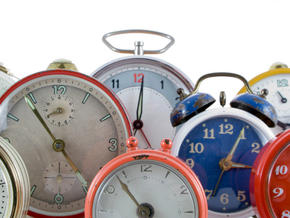
Annually my college students battle to understand all the methods we measure time. It’s comprehensible when you think about the various exceptions to the foundations. Take, for instance, the months on the calendar. Thirty days or thirty-one? After which there’s February. Adopting daylight saving time is elective. The army’s clock is totally different than a civilian’s clock. One minute looks like a second whenever you’re taking a math details quiz, however extra like an hour if you happen to’re standing on one leg. All of this could make measuring time appear very arbitrary. A method so as to add that means to this important talent is to have your class analysis the ways in which people have measured time all through historical past.
From Celestial Objects to Calendars
The solar, moon, and stars have marked time ever since people wanted to maintain monitor of its passage. It was the Egyptians who devised the primary calendar with 12 months. They realized that the “Canine Star” in Canis Main rose subsequent to the solar each 12 months, about the identical time that the annual inundation of the Nile started. The Mayans relied on the solar, moon, and the planet Venus to plot their calendar.
The Romans devised the trendy calendar and named the months after their emperors. Initially, the months alternated between thirty and thirty-one days. Nevertheless, this sample prompted August to be shorter than July. So as to keep away from offending Caesar Augustus, for whom August was named, that month was given an additional day to make it equal to the month named for Julius Caesar.
An error within the Julian calendar created an additional day each 128 years, which threw off the Vernal Equinox. The Gregorian calendar, adopted in 1582, corrected this downside. Researching one among these calendars will deepen your college students’ understanding of the typically unpredictable nature of the calendar. You can even have your class design a poster explaining the attributes and flaws of their assigned calendar.
The Creation of Hours and Minutes
As civilizations flourished and governments and formal religions had been established, people discovered a necessity for extra breakdowns of time. Sundials and water clocks allowed for smaller incremental measurements. Monks even used burning candles to mark time. Atomic clocks revolutionized people’ capacity to maintain monitor of time down to some thousandths of a second. The Nationwide Institute of Requirements and Expertise has a useful web site on the historical past of time-keeping units.
Put up places of work and libraries typically show clocks that present the time in varied cities around the globe. By hanging a number of clocks across the classroom, college students will get a really feel for time zones. Beneath every clock, you’ll be able to publish questions akin to:
- What time is it the place you reside?
- What’s going to individuals on this metropolis be doing when you find yourself consuming breakfast?
Remember to show a map or globe the place all the world time zones could be seen.
Only a Second- A e-book for youngsters
By means of quite a few examples of time within the pure world, Only a Second by Steve Jenkins presents one other technique of measuring time in addition to the ticking arms of a clock. Whereas the textual content is simple sufficient for youthful elementary college students to learn, it presents sufficient fascinating details to enthrall older readers. Who wouldn’t marvel {that a} bumble bee’s wings beat 200 instances a second and a child blue whale positive aspects nearly ten kilos every hour? Lecturers can use the e-book as a jumping-off level for discussions about math, science, and historical past.
Measurement within the Actual World
At present, we depend on the measurement of time for transportation, monetary transactions, and even our electrical provide. In sports activities, sprinters and swimmers rely on their instances being displayed all the way down to a hundredth of a second. Ask your class to make a listing of ways in which they rely on time-keeping and examine it to the wants of individuals way back.
For different approaches to instructing the measurement of time, try these concepts on Lesson Planet:
Telling Time Timeline
Third by eighth graders analysis how time was measured throughout a historic interval or the historical past of a selected time-keeping machine. Their paperwork are merged into one timeline to show. Topic areas embody math, historical past, and know-how.
Time Foldable
Though designed for kindergarten and first grade, it is a solution to reinforce the relationships between models of time for barely larger grades, too. After being learn The Time Track by Rozanne Lanczak Williams, talk about what every individual can do in a single second, one minute, one hour, and so on. Afterwards, they make a flap e-book to recollect relationships akin to sixty seconds are in a single minute.
Monitoring the Solar
Center schoolers acquire first-hand data of how a solar dial works as they plot the place of the solar at varied instances of the 12 months. Along with making a solar dial, they hold a journal for one month or longer. The journal helps dispel many generally held beliefs in regards to the solar’s motion.
Time and Cash: Time Zones Phrase Issues
Utilizing a time-zone map and a delivery schedule, higher elementary kids remedy phrase issues about touring by time zones. This task works effectively in a middle, with cooperative studying, or as further apply.
